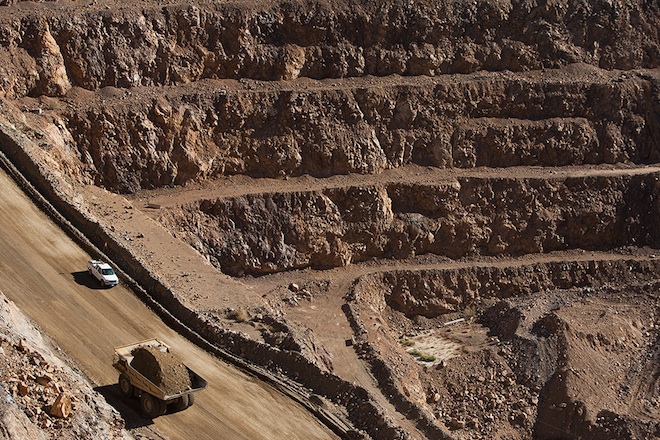By Danielle Vinton / Wired.com
The fight over the minerals that run the electronic world entered a new phase in March when the United States, the European Union and Japan collectively filed a case against China, accusing the rare-earth powerhouse of violating world trade rules to manipulate mineral prices.
At the heart of argument are 17 little-known elements with whimsical names like europium and praseodymium, that are found in everything from mobile phones and computers to smart bombs and large wind turbines. Traces of the metals can be found around the world, but rarely in high enough concentrations for mining to be convenient or profitable.
China now controls 95 percent of total rare-earth supply. A figurative sneeze on its export policy is all that’s needed to shake global markets, and in 2010 China began restricting rare-earth exports. International prices spiked, reaching near-dizzying levels last summer before crashing in the fall. In the wake of the World Trade Organization case, they’ve perked up again.
Foreign companies buying rare earths from China must now pay more than twice the rate paid by companies inside China. The tiered pricing encourages companies to move factories and jobs to China, where they can be sure of supply and lower prices. Beyond the extra economic boost for China, this has made it easier for Chinese companies to steal foreign intellectual property. Businessmen and politicians worry that China’s dominance over these 17 elements is a strategic vulnerability, discouraging innovation and threatening national defense.
That may soon change. Encouraged by rising prices and political support, new mines are starting up around the world, most notably in Malaysia and in California, where a company called Molycorp has reopened what until the 1980s was the world’s flagship rare-earth mine.
“In five years there will be rare earths produced all over the world and China will lose its edge,” said mining analyst John Kaiser, editor of Kaiser Research Online. “Molycorp is part of that equation. They’re putting back into production what was once the largest rare-earth mine in the world. And this is a good thing because it takes away power concentrated in China.”
Located in Mountain Pass, California, about an hour west of Las Vegas, the mine sits atop mineral deposits discovered in the late 1940s by geologists looking for commercial-grade uranium. They found some of the world’s richest reserves of bastnasite, a mineral containing higher-than-usual concentrations of rare-earth elements like cerium, lanthanum and yttrium.
Rare-earth mining began at Mountain Pass in the early 1950s, and by the mid-1980s the mine supplied 60 percent of global demand and 100 percent of U.S. needs. But as Chinese production increased, operations at Mountain Pass dwindled.
Environmental problems also played a role. Salty, radioactive water kept leaking from waste evaporation ponds, leading to the mine’s closure in 2002. Mining for rare earths is classically a very environmentally destructive process, and China’s market domination is due in part to disregard for health, safety and environmental controls. The country has recently started cleaning up its messiest mines, adding to export controls in pushing rare-earth prices up.
“They were cheap,” Kaiser said, “because China was willing to subsidize the price by producing things with lower environmental and health and safety controls — all the things that we over here don’t allow.”
Six years after the Mountain Pass closure, a group of private investors purchased the mine from Chevron. Molycorp is now giving the mine a $781 million overhaul, and claims it can be both profitable and environmentally responsible, operating without sucking the area dry of water, requiring massive electrical draws or leaving behind a toxic trail.
While those promises will be difficult to fulfill, one promising sign is Molycorp’s response to pressure from the Center for Biological Diversity, an environmental group that initially opposed renovation. Molycorp addressed their major concern: Rather than transporting waste water offsite through a potentially leaky pipeline, the company will recycle hydrochloric acid and water used in mining, eliminating the need for waste ponds and saving on chemical costs.
‘We’re selling everything that we’re producing before it’s even out of the ground.’
While the new technique’s details are proprietary, few doubt Molycorp’s method will genuinely be cleaner than the older extraction method.
“The mining regulations in California are probably the strictest in the world,” said Navid Mojtabai of the New Mexico Institute of Mining & Technology. “If they’ve got the permits to operate then they’re already much cleaner than the Chinese.”
As China deals with its own environmental concerns and legal complaints at the World Trade Organization, Molycorp has its own lawsuit to contend with. In February an investor filed a class-action lawsuit against Molycorp, claiming the company overstated demand for its products and its production capabilities.
While none of the lawyers contacted in connection with the case would comment, several analysts dismissed it. According to rare-earth industry analyst Judith Chegwidden, director of the Roskill Consulting Group, the market volatility of 2011 left rare-earth buyers wary, temporarily reducing demand in a way that’s frustrating to investors but not evidence of Molycorp malfeasance.
Meanwhile, Molycorp is ramping up production at Mountain Pass, and looks set to produce 40,000 tons annually by the end of 2013. As the mine begins cranking out neodymium, lanthanum and other materials by the ton, the strategic vulnerability that’s caused so much concern should be eased.
On May 10 Molycorp announced larger-than-expected profits for the year’s first business quarter. All of the the material Molycorp expects to produce in 2012 has already been spoken for, said Molycorp CEO Mark Smith. “Our customers need our product,” he said. “We’re selling everything that we’re producing before it’s even out of the ground.”

